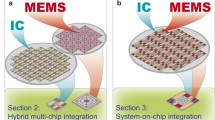Abstract
A major task for the implementation of Built-In-Self-Test (BIST) strategies for MEMS is the generation of the test stimuli. These devices can work in different energy domains and are thus designed to sense signals which are generally not electrical. In this work, we describe, for different types of MEMS, how the required non-electrical test stimuli can be induced on-chip by means of electrical signals. This provides the basis for adding BIST strategies for MEMS parts embedded in the coming generation of integrated systems. The on-chip test signal generation is illustrated for the case of MEMS transducers which exploit such physical principles as time-varying electrostatic capacitance, piezo-resistivity effect and Seebeck effect. These principles are used in devices such as accelerometers, infrared imagers, pressure sensors or tactile sensors. For implementation, we have used two major MEMS technologies including CMOS-compatible bulk micromachining and surface micromachining. We illustrate the ability to generate on-chip test stimuli and to implement a self-test strategy for the case of a complete application. This corresponds to an infrared imager that can be used in multiple applications such as overheating detection, night vision, and earth tracking for satellite positioning. The imager consists of an array of thermal pixels that sense an infrared radiation. Each pixel is implemented as a suspended membrane that contains several thermopiles along the different support arms. The on-chip test signal generation proposed requires only slight modifications and allows a production test of the imager with a standard test equipment, without the need of special infrared sources and the associated optical equipment. The test function can also be activated off-line in the field for validation and maintenance purposes.
Similar content being viewed by others
References
Analog Devices web site: http://www.analog.com/industry/iMEMS/
A. Castillejo, D. Veychard, S. Mir, J.M. Karam, and B. Courtois, “Failure Mechanisms and Fault Classes for CMOS-Compatible Microelectromechanical Systems,” in Proc. IEEE International Test Conference, Washington DC, USA, pp. 541-550, Oct. 1998.
B. Charlot, S. Mir, E.F. Cota, M. Lubaszewski, and B. Courtois, “Fault Simulation of MEMS using HDLs,” in Proc. SPIE Symposium on Design, Test and Microfabrication of MEMS/MOEMS, Paris, France, March–April 1999.
B. Charlot, S. Mir, E.F. Cota, M. Lubaszewski, and B. Courtois, “Fault Modeling of Suspended Thermal MEMS,” in Proc. IEEE International Test Conference, Atlantic City, NJ, USA, Sept. 28–30, 1999.
B. Charlot, S. Moussouris, S. Mir, and B. Courtois, “Fault Modeling of Electrostatic Comb-Drives for Mems,” in Proc. SPIE Symposium on Design, Test and Microfabrication of MEMS/MOEMS, Paris, France, March–April 1999.
A. Cozma Lapadatu, H. Jakobsen, and R. Puers, “A New Concept for a Self-Testable Pressure Sensor Based on the Bimetal Effect,” Tech Digest 10th International Conference on Solid-State Sensors and Actuators (Transducers'99), Sendai, Japan, June 7–10, 1999.
Cronos web site: http://www.memsrus.com
N. Deb and R.D. Blanton, “High Level Fault Modeling in Surface Micromachined MEMS,” Proc. Symposium on Design, Test, Integration and Packaging of MEMS/MOEMS, Paris, May 9–11 2000.
International Technology Roadmap for Semiconductors, 1999 edition.
J.M. Karam, B. Courtois, J.M. Paret, and H. Boutamine, “Low Cost Access to MST: Manufacturing Techniques and Related CAD Tools,” MST'96, Berlin, Germany, Sept. 17–19, 1996.
A. Kopelkwar and R.D. Blanton, “Development of a MEMS Testing Methodology,” in Proc. IEEE International Test Conference, Washington DC, USA, 1997.
A. Kopelkwar, R.D. Blanton, and D. Woodwilla, “Failure Modes in Surface Micromachining MEMS,” in Proc. IEEE International Test Conference, Washington DC, USA, pp. 541-550, Oct. 1998.
S.L. Miller, M.S. Rogers, G. LaVigne, J.J. Sniegowski, P. Clews, D.M. Tanner, and K.A. Peterson, “Failure Modes in Surface Micromachined Microelectromechanical Actuators,” IEEE International Reliabilty Physics Symposium Proceedings, IRPS 1998, March 31–April 2, 1998, pp. 17-25.
S. Mir and B. Charlot, “On The Integration of Design and Test for Chips Embedding MEMS,” IEEE Design and Test of Computers, Vol. 16, Oct–Dec 1999.
S. Mir, B. Charlot, G. Nicolescu, P. Coste, F. Parrain, N. Zerganoh, B. Courtois, A. Jerraya, and M. Rencz, “Towards Design and Validation of Mixed Technology SOCs,” Proc. 10th Great Lakes Symposium on VLSI, Chicago USA, 2000.
T. Olbrich, A. Richardson, B. Straube, and W. Vermeiren, “Integrated Test Support for Micro-Electro-Mechanical-Systems (MEMS),” in Proc. 5th International Conference on Micro-, Electro-, Opto-, Mechanical Systems and Components, Potsdam, Germany, Sept. 1996, pp. 273-279.
K. Peterson, P. Tangyunyong, and A. Pimentel, “Failure Analysis of Surface Micromachined Microengines,” in Material and Device Characterisation in Micromachining, Santa Clara, CA, Sept. 21–22, 1998, Vol. 3512, pp. 190-200.
S.T. Picraux and P.J. McWorther, “The Broad Sweep of Integrated Microsystems,” IEEE Spectrum, Vol. 35, Dec. 1998.
R. Rosing, A. Richardson, A. Dorey, and A. Peyton, “Test Support Strategies for MEMS.” in Proc. IEE International Mixed Signal Testing Workshop, Vancouver, Canada, 1999.
Sandia National Laboratories web site: http://www.mdl.sandia.gov/
W.C. Tang, “Overview of Microelectromechanical Systems and Design Processes,” in Proc. Design Automation Conference, Anaheim, USA, 1997.
S.C. Terry, H.V. Allen, and D.W. De Bruin, “Accelerometer Systems with Self-Testable Features,” Sensors and Actuators, Vol. 20, pp. 153-161, 1989.
L. Zimmermann, J.Ph. Ebersohl, F. Le Hung, J.P. Berry, F. Baillieu, P. Rey, B. Diem, S. Renard, and P. Caillat, “Airbag Application: A Microsystem Including a Silicon Capacitive Accelerometer, CMOS Switched Capacitor Electronics and True Self-Test Capability,” Sensors and Actuators A, Vol. 46–47, pp. 190-195, 1995.
Author information
Authors and Affiliations
Rights and permissions
About this article
Cite this article
Charlot, B., Mir, S., Parrain, F. et al. Generation of Electrically Induced Stimuli for MEMS Self-Test. Journal of Electronic Testing 17, 459–470 (2001). https://doi.org/10.1023/A:1012860420235
Issue Date:
DOI: https://doi.org/10.1023/A:1012860420235



